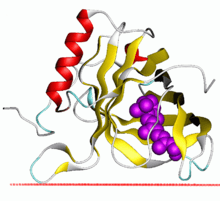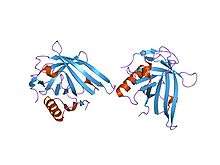Lipocalin
The lipocalins are a family of proteins which transport small hydrophobic molecules such as steroids, bilins, retinoids, and lipids. They share limited regions of sequence homology and a common tertiary structure architecture.[2][3][4][5][6] This is an eight stranded antiparallel beta barrel with a repeated + 1 topology enclosing an internal ligand binding site.[4][5]
 | |||||||||
| Identifiers | |||||||||
|---|---|---|---|---|---|---|---|---|---|
| Symbol | Lipocalin | ||||||||
| Pfam | PF00061 | ||||||||
| Pfam clan | CL0116 | ||||||||
| InterPro | IPR000566 | ||||||||
| PROSITE | PDOC00187 | ||||||||
| SCOPe | 1hms / SUPFAM | ||||||||
| OPM superfamily | 50 | ||||||||
| OPM protein | 1kt6 | ||||||||
| |||||||||
| Lipocalin-like domain | |||||||||
|---|---|---|---|---|---|---|---|---|---|
 Structure of the Escherichia coli lipocalin.[1] | |||||||||
| Identifiers | |||||||||
| Symbol | Lipocalin_2 | ||||||||
| Pfam | PF08212 | ||||||||
| Pfam clan | CL0116 | ||||||||
| InterPro | IPR013208 | ||||||||
| |||||||||
These proteins are found in gram negative bacteria, vertebrate cells, and invertebrate cells, and in plants. Lipocalins have been associated with many biological processes, among them immune response, pheromone transport, biological prostaglandin synthesis, retinoid binding, and cancer cell interactions.
Function
Immune response
Lipocalin proteins are involved in inflammation and detoxification processes caused by immune system activation in mammals. They are known respiratory allergens of mice, cats, dogs, horses, and other animals. Examples of lipocalin proteins involved in immune system responses include alpha-1-microglobulin, alpha-1-acid glycoprotein, and C8gamma. Structural information for many immune system influencing lipocalin proteins is available, while their exact role in biological systems is still somewhat unclear. Lipocalin allergens have been shown to evoke a Th2-deviated immune response, important for allergic sensitization, when applied in their apo-form (with an empty calyx devoid of ligands), whereas the holo-form seemed to exert immune-suppressive properties in vitro.[7]
Pheromone transport
The lipocalin family has been connected with the transport of mammalian pheromones due to easily observable protein-pheromone interactions. Lipocalins are comparatively small in size, and are thus less complicated to study as opposed to large, bulky proteins. They can also bind to various ligands for different biological purposes. Lipocalins have been detected as carrier proteins of important pheromones in the nasal mucus of rodents. Major urinary proteins, a lipocalin subfamily, are found in mouse and rat urine and may act as protein pheromones themselves.[8]
Prostaglandin synthesis
This family of proteins plays a part in the biological system of terminal prostaglandin synthesis.
Retinoid binding
Retinol, (vitamin A), is an important micronutrient that affects eyesight, cell differentiation, immune system function, bone growth, and tumor suppression. Retinol absorption and metabolism depends on lipocalins that act as binding proteins. Retinyl esters (present in meats) and beta-carotene (present in plants) are the two main sources of retinoids in the diet. After intake, they are converted to retinol, successively metabolized, and finally bound to retinol binding proteins (lipocalins) in the blood plasma.
Cancer cell interactions
Because lipocalins are extracellular proteins, their intracellular effects are not obvious, and demand further study. However, lipophilic ligands, present as substituents to the lipocalins, have the ability to enter the cell, where they can act as tumor protease inhibitors. This research suggests another possible route of protein-tumor investigations.
Allergens
Some of the proteins in this family are allergens. Allergies are hypersensitivity reactions of the immune system to specific substances called allergens (such as pollen, stings, drugs, or food) that, in most people, result in no symptoms. A nomenclature system has been established for antigens (allergens) that cause IgE-mediated atopic allergies in humans.[9] This nomenclature system is defined by a designation that is composed of the first three letters of the genus; a space; the first letter of the species name; a space and an Arabic number. In the event that two species names have identical designations, they are discriminated from one another by adding one or more letters (as necessary) to each species designation.
The allergens in this family include allergens with the following designations: Bla g 4, Bos d 2, Bos d 5, Can f 1, Can f 2, Fel d 4, Equ c 1 and Equ c 2.
Hormone
LCN2 (Lipocalin 2) acts as bone-derived hormone which crosses the BBB and acts on PVN paraventricular nucleus of hypothalamus in the brain.
Structure
Although lipocalins are a broad family of greatly varied proteins, their three-dimensional structure is a unifying characteristic. Lipocalins have an eight-stranded, antiparallel, symmetrical β-barrel fold, which is, in essence, a beta sheet which has been rolled into a cylindrical shape. Inside this barrel is located a ligand binding site, which plays an important role in the lipocalin classification as a transport protein. If lipocalins are genetically engineered in the attempt to modify their binding properties, they are called anticalins.
Family members
The name "lipocalin" has been proposed[2] for this protein family, but cytosolic fatty acid binding proteins are also included. The sequences of most members of the family, the core or kernel lipocalins, are characterised by three short conserved stretches of residues, while others, the outlier lipocalin group, share only one or two of these.[5][10] Proteins known to belong to this family include alpha-1-microglobulin (protein HC); major urinary proteins; alpha-1-acid glycoprotein (orosomucoid);[11] aphrodisin; apolipoprotein D; beta-lactoglobulin; complement component C8 gamma chain;[12] crustacyanin;[13] epididymal-retinoic acid binding protein (E-RABP);[14] insectacyanin; odorant binding protein (OBP); human pregnancy-associated endometrial alpha-2 globulin (PAEP); probasin (PB), a prostatic protein; prostaglandin D synthase;[15] purpurin; Von Ebner's gland protein (VEGP);[16] and lizard epididymal secretory protein IV (LESP IV).[17]
Human proteins that contain lipocalin domain include:
- AMBP, APOD
- C8G, CRABP1, CRABP2
- FABP1, FABP2, FABP3, FABP4, FABP5, FABP6, FABP7
- LCN1, LCN2, LCN8, LCN9, LCN10, LCN12
- OBP2A, OBP2B
- ORM1, ORM2
- PAEP, PERF15, PMP2, PTGDS
- RBP1, RBP2, RBP4, RBP5, RBP7
- UNQ2541
See also
- Retinol binding protein
References
- Campanacci V, Nurizzo D, Spinelli S, Valencia C, Tegoni M, Cambillau C (March 2004). "The crystal structure of the Escherichia coli lipocalin Blc suggests a possible role in phospholipid binding". FEBS Lett. 562 (1–3): 183–8. doi:10.1016/S0014-5793(04)00199-1. PMID 15044022.
- Pervaiz S, Brew K (1987). "Homology and structure-function correlations between alpha 1-acid glycoprotein and serum retinol-binding protein and its relatives". FASEB J. 1 (3): 209–214. doi:10.1096/fasebj.1.3.3622999. PMID 3622999.
- Nagata A, Igarashi M, Toh H, Urade Y, Hayaishi O (1992). "Structural organization of the gene for prostaglandin D synthase in the rat brain". Proc. Natl. Acad. Sci. U.S.A. 89 (12): 5376–5380. Bibcode:1992PNAS...89.5376I. doi:10.1073/pnas.89.12.5376. PMC 49294. PMID 1608945.
- Cowan SW, Jones TA, Newcomer ME (1990). "Crystallographic refinement of human serum retinol binding protein at 2A resolution". Proteins. 8 (1): 44–61. doi:10.1002/prot.340080108. PMID 2217163.
- Flower DR, Attwood TK, North AC (1993). "Structure and sequence relationships in the lipocalins and related proteins". Protein Sci. 2 (5): 753–761. doi:10.1002/pro.5560020507. PMC 2142497. PMID 7684291.
- Godovac-Zimmermann J (1988). "The structural motif of beta-lactoglobulin and retinol-binding protein: a basic framework for binding and transport of small hydrophobic molecules?". Trends Biochem. Sci. 13 (2): 64–66. doi:10.1016/0968-0004(88)90031-X. PMID 3238752.
- Roth-Walter, Franziska; Pacios, Luis F.; Gomez-Casado, Cristina; Hofstetter, Gerlinde; Roth, Georg A.; Singer, Josef; Diaz-Perales, Araceli; Jensen-Jarolim, Erika (2014-08-12). "The Major Cow Milk Allergen Bos d 5 Manipulates T-Helper Cells Depending on Its Load with Siderophore-Bound Iron". PLOS ONE. 9 (8): e104803. Bibcode:2014PLoSO...9j4803R. doi:10.1371/journal.pone.0104803. PMC 4130594. PMID 25117976.
- Chamero P, Marton TF, Logan DW, Flanagan K, Cruz JR, Saghatelian A, Cravatt BF, Stowers L (December 2007). "Identification of protein pheromones that promote aggressive behaviour". Nature. 450 (7171): 899–902. Bibcode:2007Natur.450..899C. doi:10.1038/nature05997. PMID 18064011. Lay summary – BBC News.
- [WHO/IUIS Allergen Nomenclature Subcommittee King T.P., Hoffmann D., Loewenstein H., Marsh D.G., Platts-Mills T.A.E., Thomas W. Bull. World Health Organ. 72:797-806(1994)]
- Flower DR, Attwood TK, North AC (1991). "Mouse oncogene protein 24p3 is a member of the lipocalin protein family". Biochem. Biophys. Res. Commun. 180 (1): 69–74. doi:10.1016/S0006-291X(05)81256-2. PMID 1834059.
- Wilting J, Kremer JM, Janssen LH (1988). "Drug binding to human alpha-1-acid glycoprotein in health and disease". Pharmacol. Rev. 40 (1): 1–47. PMID 3064105.
- Peitsch MC, Tschopp J, Jenne DE, Haefliger JA (1991). "Structural and functional characterization of complement C8 gamma, a member of the lipocalin protein family". Mol. Immunol. 28 (1): 123–131. doi:10.1016/0161-5890(91)90095-2. PMID 1707134.
- Keen JN, Caceres I, Eliopoulos EE, Zagalsky PF, Findlay JB (1991). "Complete sequence and model for the A2 subunit of the carotenoid pigment complex, crustacyanin". Eur. J. Biochem. 197 (2): 407–417. doi:10.1111/j.1432-1033.1991.tb15925.x. PMID 2026162.
- Newcomer ME (1993). "Structure of the epididymal retinoic acid binding protein at 2.1 A resolution". Structure. 1 (1): 7–18. doi:10.1016/0969-2126(93)90004-Z. PMID 8069623.
- Boguski MS, Peitsch MC (1991). "The first lipocalin with enzymatic activity". Trends Biochem. Sci. 16 (10): 363. doi:10.1016/0968-0004(91)90149-P. PMID 1723819.
- Kock K, Ahlers C, Schmale H (1994). "Structural organization of the genes for rat von Ebner's gland proteins 1 and 2 reveals their close relationship to lipocalins". Eur. J. Biochem. 221 (3): 905–916. doi:10.1111/j.1432-1033.1994.tb18806.x. PMID 7514123.
- Morel L, Depeiges A, Dufaure JP (1993). "LESP, an androgen-regulated lizard epididymal secretory protein family identified as a new member of the lipocalin superfamily". J. Biol. Chem. 268 (14): 10274–10281. PMID 8486691.
Further reading
- Paine K, Flower DR (October 2000). "The lipocalin website". Biochim. Biophys. Acta. 1482 (1–2): 351–2. doi:10.1016/S0167-4838(00)00166-7. PMID 11058775.
- Virtanen T, Zeiler T, Mäntyjärvi R (December 1999). "Important animal allergens are lipocalin proteins: why are they allergenic?". Int. Arch. Allergy Immunol. 120 (4): 247–58. doi:10.1159/000024277. PMID 10640908.
- Bratt T (October 2000). "Lipocalins and cancer". Biochim. Biophys. Acta. 1482 (1–2): 318–26. doi:10.1016/S0167-4838(00)00154-0. PMID 11058772.
- Charron JB, Ouellet F, Pelletier M, Danyluk J, Chauve C, Sarhan F (December 2005). "Identification, expression, and evolutionary analyses of plant lipocalins". Plant Physiol. 139 (4): 2017–28. doi:10.1104/pp.105.070466. PMC 1310578. PMID 16306142.
- Novotny MV (February 2003). "Pheromones, binding proteins and receptor responses in rodents". Biochem. Soc. Trans. 31 (Pt 1): 117–22. doi:10.1042/BST0310117. PMID 12546667.
External links
- Lipocalins in SCOP database
- UMich Orientation of Proteins in Membranes families/superfamily-52 - Calculated spatial positions of some Lipocalins in membranes